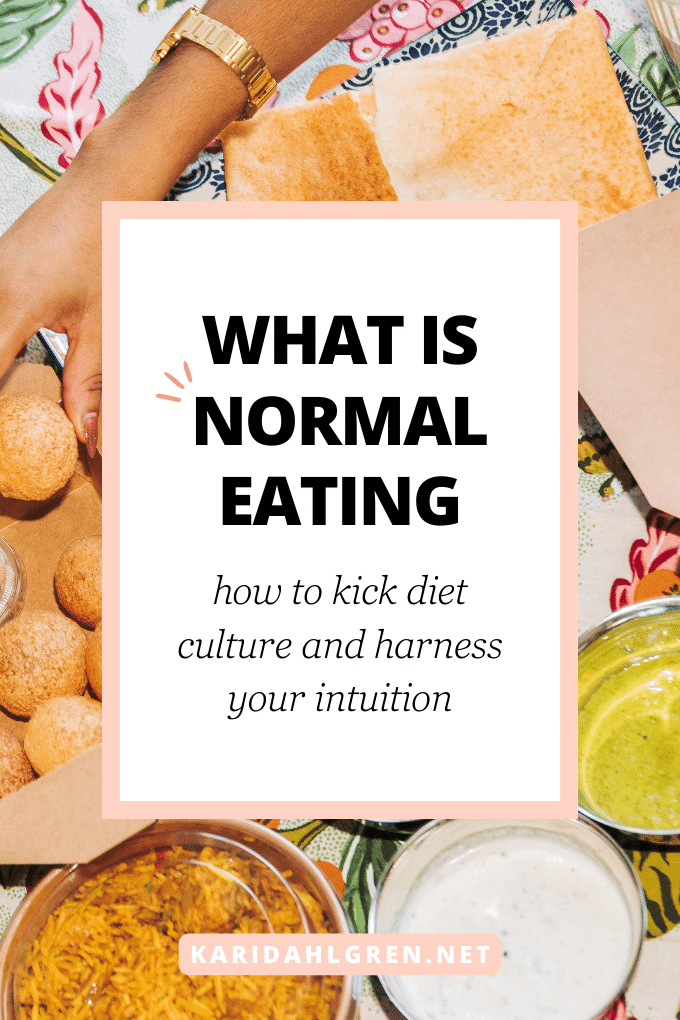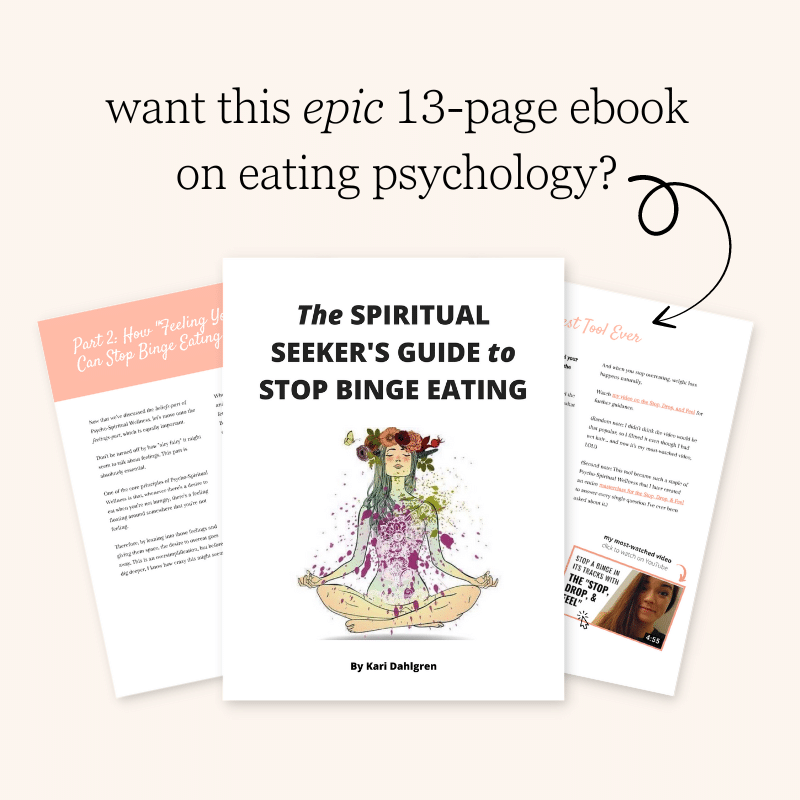
Chances are, when you were a young child, you never had to ask, “What is normal eating?” Chances are, you ate when you were hungry and stopped when you were full. It was so natural that you barely had to think about it; and once you ate, you completely stopped thinking about food and moved on.
Dieting often strips away this freedom. It sows seeds of doubt in our food choices and can escalate into an unhealthy preoccupation or obsession with food. Although diet culture is rampant, it’s possible rediscover “how to eat like a normal person” again. (I put this in quotes because, although it’s a goal that most of us can relate to, ‘normal’ looks different for everyone.)
This article explains the steps you can take to get back to “normal eating.” I’ll also explain how to navigate fears of weight gain with intuitive eating, because it’s one of the biggest barriers to letting go of the food rules.
What Is Normal Eating?
A systematic review and meta-analysis published in the journal Obesity Review reveals that between 42-44% of adults are actively trying to lose weight—globally—while another 23% actively try to maintain their current weight.[1]
In other words, dieting and weight-control behaviors have become the new normal. When the majority of the global population is engaged with food rules and calorie counting, what is normal eating—truly?
Normal eating is the practice of following your intuition to decide what and when to eat. It means eating when you’re hungry, choosing foods that you find satisfying and nourishing, and stopping when you’re full. There’s no counting Weight Watchers Points, no tracking calories or weighing your food. It’s simply about listening to your body.
Normal eating is an intuitive, natural behavior—it’s the way you ate as a small child. In contrast, dieting is a learned behavior, and when it’s over-practiced or excessively employed, it can override our natural intuition.
Given our culture’s fixation on dieting and body image, it’s arguably more common to feel estranged from normal eating than familiar with it. If you’re keen on rediscovering what normal eating is, you’re not alone.
How to Eat Normally Again: Ditching Diet Culture in Favor of Intuitive Eating
As we move away from the diet-centric norms that pervade our society, it’s essential to understand the practical steps we can take to rediscover the way we used to eat before diet culture took hold. By relearning how to listen to your body again, you can break free from the constraints of dieting and begin to experience the true freedom that comes with normal eating.
Here are helpful steps for learning how to eat normally again:
1. Rely on Internal Body Cues
Honoring internal body cues such as hunger and fullness is essential for normal eating. This approach encourages listening to your body’s natural signals rather than strictly following external eating schedules or dietary rules.
Research published in The Journal of the Academy of Nutrition and Dietetics supports that individuals who engage with their internal cues often experience enhanced psychological health and maintain a healthier relationship with food, making it a vital characteristic of balanced eating.[2]
2. Embrace Dietary Flexibility
Normal eating means eating based on hunger, appetite, and pleasure, not strictly regulated mealtimes (“eating by the clock”) or rigid rules. Diet culture has generated fears of weight gain around eating pleasurable foods, and yet a scoping review published in the journal PLoS (Public Library of Science) One shows that eating pleasure is a catalyst for healthy eating and even a healthy eating recommendation.[3] Don’t let diet culture shame you out of the joyful eating experience that you deserve.
3. Consider Emotional Flexibility
Despite common belief, emotional eating can occasionally complement normal eating patterns, as it reflects a natural variation in response to our emotions—both positive and negative. A study published in The Proceedings of the Nutrition Society suggests that while emotional eating is more pronounced in individuals with eating disorders, it can also occur in healthy individuals without necessarily leading to unhealthy outcomes, especially when emotional eating is not your sole coping mechanism.[4]
4. Incorporate Variety
Normal eating involves consuming a wide range of foods without labeling them as “good” or “bad”. A study published in The British Journal of Nutrition shows that up to one-fifth of your food intake can include low-nutrient foods without compromising overall nutritional quality.[5] This supports the notion that all foods can fit into a balanced diet
5. Cultivate Guiltless Experiences
Learning “how to eat like a normal person” again—more appropriately, learning how to feel normal around food again—means cultivating a joyful eating experience without guilt. When you eat the foods that appeal to you, there is no need for self-reproach, even if those foods are labelled by external sources as “junk foods.” Getting back to normal eating means acknowledging that all foods can be a part of a healthy diet.
6. Don’t Skip Satisfaction
Imposing strict diet rules often leads to feelings of deprivation, where certain foods are viewed as forbidden, intensifying cravings and a sense of missing out. This restrictive approach can inadvertently trigger a restrict-binge cycle.
To counteract this, incorporating satisfaction into meals is key. Allowing oneself to enjoy a variety of foods that include those previously deemed “off-limits” can lead to a more balanced and joyful relationship with eating. Indeed, a randomized controlled trial (the most rigorous type of clinical trial) published in Psychological Medicine found that reducing dietary restraint helped reduce binge eating.[6]
7. Practice Gentle Nutrition
Gentle nutrition is an approach that emphasizes eating foods that not only satisfy your taste buds but also nourish your body, without imposing strict dietary rules. It’s about making food choices that honor both your health and your palate, integrating nutritional considerations with a kind and forgiving attitude towards oneself. Gentle nutrition is a key characteristic of normal eating.
Sometimes, when someone first gives up dieting, they may struggle with “entitlement eating” by consuming low-nutrient foods in abundance simply because they can. The concept of gentle nutrition helps shift entitlement eating back towards normal eating, as food choices are made based on how they make your body feel along with true satisfaction.
How to Navigate Fears of Weight Gain

Letting go of the food rules can feel groundless and uncertain, triggering fears of weight gain. This is arguably one of the biggest barriers to learning “how to eat like a normal person” again.
On my own journey of rediscovering normal eating and curbing compulsive eating, I felt this fear too. What pushed me to finally give up dieting was feeling utterly fed up with gaining and losing the same 15 pounds every few months. For you, the process may look different.
If the fear of weight gain feels stronger than your desire to get back to normal eating, then you might find some insightful motivation by understanding set point weight theory. It suggests that your body naturally gravitates towards a certain weight range where it functions optimally.
By following the principles of normal eating, you allow your body to regulate hunger, appetite, and metabolism without external interference, likely stabilizing your weight naturally over time. For me, the most encouraging discovery I made is that dieting is correlated with a higher set point weight than intuitive eating (source: Health at Every Size).
Transitioning to normal eating involves embracing a broader definition of health, one that includes mental, emotional, and physical well-being, rather than focusing solely on weight. This shift can help alleviate fears of weight gain as you learn to trust your body’s innate ability to maintain its health.
Normal Eating Is Relaxed, Peaceful, and Intuitive
As you take the first steps towards rediscovering normal eating, remember that this journey is deeply personal and uniquely yours. The path away from restrictive diets towards an intuitive approach might feel daunting at first. Yet, it’s a path filled with liberation and self-discovery.
Normal eating is about finding joy in the flavors that delight you, learning to trust the wisdom of your body, and ultimately, giving yourself the grace to explore what truly feels good. Here’s to finding peace at the table and within yourself—a peace that is well-deserved and profoundly healing.




Your explanations and emphasis on gentleness are really appealing to me. Intuitive eating has always felt inaccessible to me, as a person with a history of disordered eating. I’m convinced this is the right way to do things, and the words you use, like Stop, Drop and Feel, are very sticky! They don’t feel like shaming. Thanks Kari!
Hi Jenifer! I am so glad that I can help make intuitive eating feel more accessible! That makes my heart feel so full. I agree that some, not all but some, intuitive eating sources can be oddly rooted in shame. And I am glad my words are sticky! 🙂 You are so good at compliments, and making others feel seen.